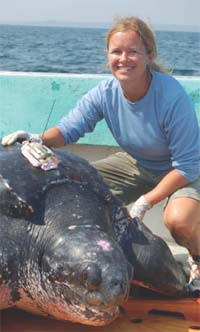 |
 |
| current issue |  |
past issues |  |
send a letter/news |  |
address update |  |
advertise |  |
about us |  |
alumni home |
Campus Currents
Turtle TouristsTagged leatherbacks tell their secrets
By David Brooks

TAG ALONG: Grad student Kara Dodge with a tagged leatherback turtle. |
Jellyfish are increasing in numbers worldwide, but annoyed swimmers have a mysterious friend: leatherback sea turtles. Leatherbacks eat jellyfish. Lots of them.
"Juveniles need to eat their body weight per day in jellyfish just to maintain weight, let alone grow," says Kara Dodge, a doctoral student who is part of a UNH team that tagged leatherbacks with transmitters south of Cape Cod last summer.
Nobody's certain if things are the same with adults—not much is known about leatherbacks, which do poorly in captivity—but it seems likely. If so, the gastronomic tally is staggering because leatherbacks, who divide their time between warm and cold waters, are among the world's largest reptiles, with adults weighing as much as a ton.
It was the third leatherback-tagging field season for the Large Pelagics Research Center, led by professor Molly Lutcavage. Last summer proved to be a bonanza year, with 12 adults tagged by the time the program ended in September.
When the turtles surface, a transmitter sends data to a satellite, indicating the turtle's location, how deep it has dived and for how long. Researchers will study the data for clues about the behavior of these prehistoric-looking beasts.
Easy to print version
blog comments powered by Disqus
